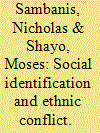| Srl | Item |
| 1 |
ID:
123886


|
|
|
|
|
| Publication |
2013.
|
| Summary/Abstract |
During the Cold War, Nordic cooperation blossomed and the region's identity was strong, yet defence was left outside the Nordic framework. After the end of the Cold War, Nordic cooperation waned and it was largely replaced by cooperation within the framework of the European Union. During the past couple of years, however, Nordic defence cooperation has been boosted by a number of initiatives and common projects.
This article analyses this recent rise of Nordic defence cooperation. In terms of theory, it revolves around the question of how material and identity factors explain security cooperation in today's Europe.
During the Cold War, identity was an easy explanation for societal cooperation between the Nordic countries, but geostrategic factors and national interests based on them determined (the lack of) defence cooperation. Even today, Nordic defence cooperation is justified more by cost-efficiency and geographical proximity than by common identity.
This article argues that Nordic identity nevertheless plays an important role in motivating defence cooperation. It is not driven by pure cost-efficiency or strategic calculation. The role of identity needs to be understood, however, not as a kind of independent force but as part of the political process.
Nordic identity explains the rise of the region's defence cooperation in two ways: it facilitates informal cooperation between defence officials at various levels, and it is easy to sell international defence cooperation politically to domestic audiences if it is done in the Nordic context. Yet Nordic cooperation is not seen as contradicting European or NATO cooperation.
|
|
|
|
|
|
|
|
|
|
|
|
|
|
|
|
| 2 |
ID:
121123


|
|
|
|
|
| Publication |
2013.
|
| Summary/Abstract |
When do ethnic cleavages increase the risk of conflict? Under what conditions is a strong common identity likely to emerge, thereby reducing that risk? How are patterns of social identification shaped by conflict? We draw on empirical results regarding the nature and determinants of group identification to develop a simple model that addresses these questions. The model highlights the possibility of vicious and virtuous cycles where conflict and identification patterns reinforce each other. It also shows how processes of ethnic identification amplify the importance of political institutions and traces the effects of national status and perceived differences across ethnic groups. Finally, we demonstrate how a small but sufficiently potent group of ethnic radicals can derail a peaceful equilibrium, leading to the polarization of the entire population. We reexamine several historical cases as well as empirical correlates of civil wars in light of these results.
|
|
|
|
|
|
|
|
|
|
|
|
|
|
|
|